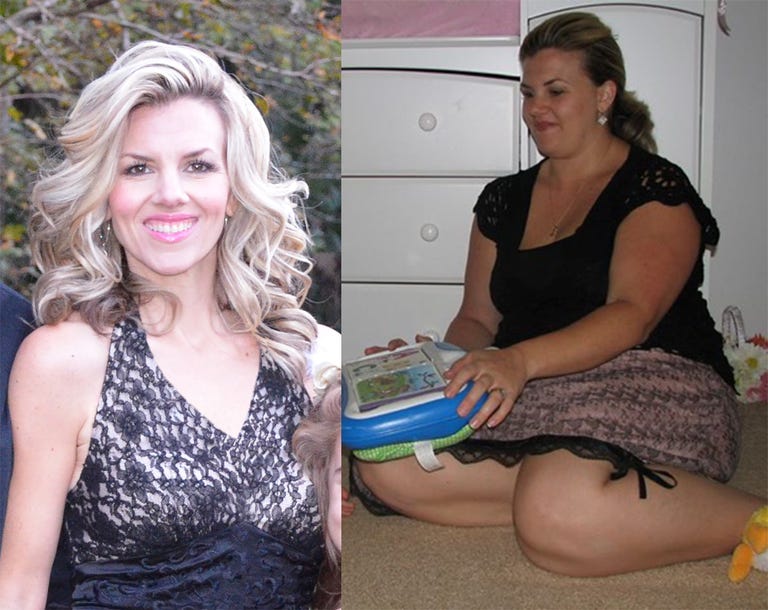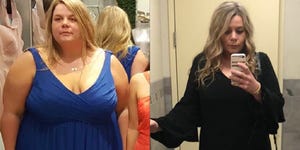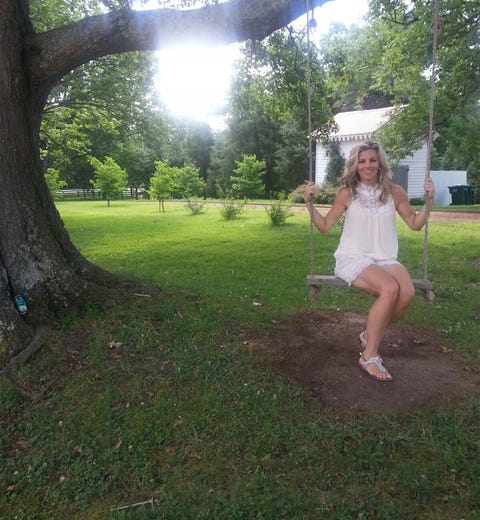
I started gaining weight in high school—eating was a social pastime with friends, so rather than listening to what my body actually needed, I indulged more often than not. Despite being on the pom squad with three-hour practices each day, I went from a size seven to a size 12 in just four years.
After high school, I began turning to food for comfort—eating while watching TV helped me zone out. The weight kept piling on, until one day, I didn’t recognize myself in the mirror.

At first, I panicked and searched for a quick fix through the latest diets or pills. But each diet I tried inevitably failed, and each time that happened I lost a little more hope that I’d ever reach my goal weight. But all of those diets failed for the same reason: I wasn’t taking care of the emotional issues behind my eating.
I hit rock bottom when I saw my daughter mirroring my kitchen habits.
At just 1 year old, she walked into the kitchen pantry, literally following in my footsteps. She would open the pantry door and just stare at the food—she was copying my own habits. It was then that I knew I had to change for my daughter’s sake and future health.
When a friend heard I was struggling, but finally ready to lose weight, she loaned me an audio tape on the Weigh Down Diet. By then, I had been on every diet imaginable, and I was skeptical. Still, I gave it a shot—and I was pleasantly surprised.

Jaime Field
It addressed the emotional component of my overeating. Rather than focusing on a strict regimen of what you can’t eat, the program focuses on teaching you to recognize when you’re truly, physically hungry, and how to stop at the end of a meal once you’re satisfied. I realized the content of the food I was eating was not the problem—it was the huge volume. I began to differentiate between actual hunger and emotional eating.
I let go of all my old diet “rules” and disgusting foods (no more rice cakes!). I was so tired of chicken breast, egg whites, and salad that it made me sick to my stomach thinking about it. So when I felt my stomach growl, I started paying attention to what my body craved.
I never deprived myself: For breakfast, I’d have a banana with Nutella or peanut butter (or, if I felt like it that day, a small chocolate chip muffin). Lunch was typically a sandwich with just a few chips; for dinner, I’d stick to a small salad with steak, salmon, or pasta, and if I ever craved dessert I’d have a few bites of something sweet like ice cream.
At my heaviest, it was difficult and painful to exercise; but as I lost weight, I actually looked forward to being active.
I started going on walks with my daughter, pushing her in her stroller in the mornings. There’s a mile-long loop in my neighborhood, which was great for tracking my mileage.
But it wasn’t all about getting my steps in—mainly, I focused on nature and getting outside, which really helped my mental health. I used the time to pray and get my thoughts in order for the day.

Jaime Field
I made sure to stay active when I wasn’t going on walks too, through doing a fun adult ballet class, mowing the lawn, or doing yard work.
After just five months of eating better and exercising more often, I lost about 30 pounds.
Weight loss was different this time because I didn’t just change what I ate—I changed my relationship with food.
Since I started this journey 12 years ago, I’ve lost 111 pounds. Through paying attention to my body and giving it what it needed, my desires and impulses completely changed. I learned to use food as fuel, not to comfort my emotions. I am so grateful for this new focus and consider it a gift that I get to pass this new life down to my children.

Before I lost the weight I was constantly in pain, and I didn’t want to get out of my car to get gas because I didn’t want to be seen. I was worried what people thought of me all the time. I was lonely, depressed, and had lost my personality and who I really was. It affected my marriage and kept me from going and doing the things I really wanted to be doing.
Losing the weight has given me hope, freedom, and a whole new life.
Source: Read Full Article
